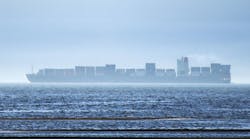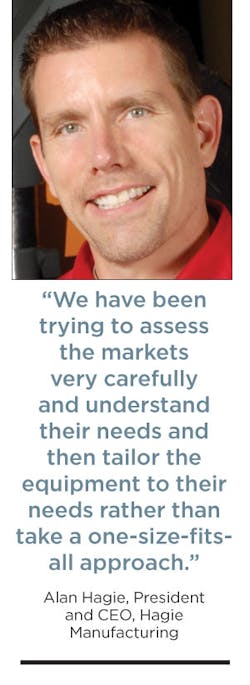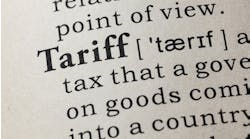Where else can we grow?
It's a question many U.S. manufacturers are pondering as they look out on the tepid state of the world's economy. While U.S. GDP is expected to grow 1.8% in 2013, the European economy is in recession and the BRIC (Brazil, Russia, India, China) countries have seen their meteoric growth slowed.
See Also: Global Manufacturing Economy Trends & Analysis
Moderating growth in these markets has helped turn attention to where U.S. companies can seek faster rates of growth. In 2005, Goldman Sachs identified the Next 11: Bangladesh, Egypt, Indonesia, Iran, Mexico, Nigeria, Pakistan, the Philippines, South Korea, Turkey and Vietnam. While duly noting that several of these countries faced "large challenges," Goldman Sachs said these countries could rival the G7 and serve as an "important source of growth and opportunity." The Economist Intelligence Unit coined the term CIVETS (Colombia, Indonesia, Vietnam, Egypt, Turkey and South Africa) in 2009 to identify another set of countries with promising economies, in part because of their youthful populations and strategic locations.
U.S. manufacturers, of course, aren't turning their backs on the domestic economy or on the BRIC nations. Scott Griffin, chief sustainability officer for Greif Inc. (IW 500/224), a manufacturer of industrial and other products, points to new energy sources as making the U.S. an attractive manufacturing environment and to recovery in Western Europe. But he says Greif, with 16,000 employees operating in 50 countries, has been making significant investments in countries such as Saudi Arabia, Turkey and India.
Greif is also taking a longer view, looking for opportunities in less developed nations such as Guatemala, Kenya and Rwanda. About two years ago, for example, the company used its packaging expertise to create the PackH2O, a backpack that allows people to carry water more comfortably than using buckets or jerry cans to carry the water on their heads. The Pack was developed after Greif CEO David Fischer went to Haiti after the 2010 earthquake, saw women struggling to get water home and thought his company could develop a better solution. Greif is working with NGOs and government agencies to preposition the backpack, currently manufactured in Turkey, for use in disaster relief.
Griffin called Africa a "very important market," noting recent United Nations estimates that the continent's population will grow from 1.1 billion currently to 2.4 billion by 2050. The PackH20, he says, is an "investment that is prudent and has a payback, but more importantly it gives us an opportunity to create a business and have a meaningful contribution to society there."
Greif's investment in Africa and other developing markets reflects the "early mover advantage" that U.S. companies should consider, says Ravi Madhavan, a business professor at the University of Pittsburgh. These investments provide companies with important opportunities to learn about a market and to help shape it.
Madhavan says these developing countries share some similarities, such as the need for infrastructure to support basic manufacturing and transportation. But he cautions they also are very different from each other and present potentially volatile business environments.
"If we had been having this conversation two years ago, Egypt would have figured prominently in it," Madhavan points out. "Now, all bets are off."
Because developing countries do vary, it's important to investigate them thoroughly, says Alan Hagie, president and CEO of Hagie Manufacturing, a farm equipment manufacturer based in Iowa. When the company began exporting in the 1960s, it tried to sell its equipment without making modifications for that market. More recently, he says, "We have been trying to assess the markets very carefully and understand their needs and then tailor the equipment to their needs rather than take a one-size-fits-all approach."
In addition, Hagie said he has come to realize the crucial role of customer support for new markets. Even where the company sells through distributors, he says, it is important to have "boots on the ground" to monitor customer relationships and ensure that customers are being served properly. Hagie says he prefers to hire people from the area who know the culture and relate well to customers and distributors.
Exports account for 25% to 30% of Hagie Manufacturing's business. The company sees its main growth markets in Russia, South Africa and Australia, but it is exploring a number of other markets such as Romania, Hungary and Poland. In June, Hagie joined a special Department of Agriculture trade mission to Turkey. The company currently sells its machines in Turkey, but primarily to U.S. customers that have operations there. But Hagie said Turkish inheritance laws actually work to shrink farm size, making it difficult to justify the purchase of his company's machines, which best suit large operations. Still, he expects to continue monitoring the market and explore opportunities at state-owned farms.
GE (IW 500/6), a $20 billion exporter, recognized the need for infrastructure in its last annual report, noting: "About $60 trillion of infrastructure investment is needed by 2030 to support billions of new consumers joining the middle class in the emerging world and to support developed market productivity. At $100 billion of revenue with 15% margins, we are the largest and most profitable infrastructure company in the world."
Already a global powerhouse, GE continues to invest in growth economies as one of its main drivers for building the company. "We have built a company that has high share in growth regions," the company stated. "In 2012, we had $40 billion of orders in growth regions, a 12% increase over the prior year and a threefold increase in the last decade."
Taking the Plunge
One issue for many U.S. manufacturers is simply deciding to become an exporter. Approximately 74,000 companies, about one-third of domestic manufacturers, currently export. That is a far higher percentage than for U.S. businesses overall, but as the National Association of Manufacturers points out, the more than $1 trillion worth of manufactured products that the U.S. exports "represents just a fraction of this country's export potential."
"Most companies will tell you that in order to grow, they have to expand beyond the U.S. market. It's not enough," says Chandra Brown, deputy assistant secretary for manufacturing at the Department of Commerce's International Trade Administration. Brown recommends that companies look for a market that provides the best and easiest entry. She said when companies begin exporting, they then typically find that "it is not that hard to export to additional countries."
Three of the countries where U.S. manufacturers should find easier entry are South Korea, Colombia and Panama, all of which established free trade agreements with the U.S. during the Obama administration. IndustryWeek asked Brown to highlight some leading export opportunities in these three countries.
South Korea: South Korea is the 13th-largest economy in the world and the seventh-largest trading partner of the U.S. When the FTA is fully implemented, says Brown, it is expected to support 70,000 jobs in the U.S. Among the market opportunities for U.S. firms, she says, South Korea is a major buyer of U.S. medical devices, pharmaceuticals and biotechnology. South Korea also is the third-largest importer of U.S. chemicals and a major market for aerospace manufacturers.
Brown says South Korea should also be a good market for U.S. nuclear power equipment. "Korea has contracts to build commercial nuclear light water reactor facilities in countries like the UAE and Turkey," she says.
Colombia: The third-largest economy in Central and South America, Colombia's GDP is expected to grow at a 4.1% clip in 2013. The U.S. accounted for nearly a quarter of Colombia's imports in 2012. U.S. exports to Colombia grew 14% in 2012 and climbed 22.4% in the first quarter of this year compared to the same period in 2012.
"One of the areas to focus on will be oil and gas," said Brown. She noted that Colombia has a goal of producing 1.3 million barrels of oil a day by 2020 and is interested in developing its nonconventional gas resources such as shale and expanding its domestic refining capacity. U.S. technology leads in the development of shale resources, so it presents an excellent opportunity for U.S. firms, says Brown.
The Colombian government has also announced $26 billion in spending over the next four years to improve the nation's infrastructure. "That is obviously going to boost demand for U.S. machinery and equipment exports," said Brown.
Panama: Panama's economy is expected to grow 9.0% in 2013. In 2012, U.S. merchandise exports to Panama totaled $9.9 billion, a 21% increase from 2011. Export categories showing major growth to Panama include petroleum and coal, miscellaneous manufactured commodities, and computers and electronic products.
Facing Tough Competition
In a recent Deloitte survey of nearly 630 executives, 28% said their companies were generating 30% or more of their revenue from 10 emerging markets (China, India, Southeast Asia, South Korea, Brazil, Latin America, Eastern Europe and Russia, Turkey, Egypt and South Africa). But in three years, these executives predicted, their companies will garner more than half of their revenue from these markets.
For U.S. and other western multinational companies, however, the companies that are coming out of these markets will present a formidable challenge, says Jim O'Gara, director, Deloitte Financial Advisory Services. They are used to operating in difficult environments and expect rapid growth. "They are looking at how they can double their business in five years," he said.
O'Gara said these aggressive companies are honing business models learned in their home markets and applying the lessons to expand to adjacent regions and globally.
"They can find ways to build their brands from a low-margin, more primitive brand and gradually build it out," he says, employing innovation to develop products that are appropriate for local markets.
Whether U.S. companies are considering these new emerging markets or more familiar trading partners, Brown urges manufacturers to contact ITA's Commercial Service officers. "They are a great first line that should be used and consulted as manufacturers move forward," she said. ITA also offers a variety of other services to help companies with issues such as removing trade barriers. These resources and others are available at trade.gov.






